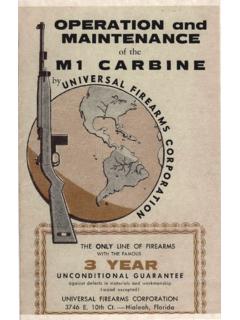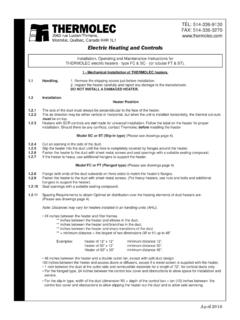Transcription of NFPA 1001 Standard - Jones & Bartlett Learning
1 Chapter Pretests Interactivities Hot Term Explorer Web Links Review Manual FireLearn Skill Drills Voices of Experience Fire Marks Teamwork Tips Fire Fighter Safety Tips Fire Fighter Tips Canadian Perspectives Hot Terms Wrap-Up nfpa 1001 Standard nfpa 1976, Standard on Protective Ensemble for Proximity Firefighting nfpa 1977, Standard on Protective Clothing and Equipment for Wildland Fire Fighter I Firefighting General Skill Requirements. The ability to don personal protective nfpa 1981, Standard on Open-Circuit Self-Contained Breathing Apparatus for clothing within one minute; doff personal protective clothing and prepare for Fire and Emergency Services reuse; hoist tools and equipment using ropes and the correct knot; tie a bowline, nfpa 1982, Standard on Personal Alert Safety Systems (PASS). clove hitch, figure eight on a bight, half hitch, becket or sheet bend, and safety knots; and locate information in departmental documents and Standard or code materials.
2 Knowledge Objectives Use SCBA during emergency operations, given SCBA and other personal After completing this chapter, you will be able to: protective equipment, so that the SCBA is correctly donned and activated within Discuss the educational, age, medical, physical fitness, and emergency one minute, the SCBA is correctly worn, controlled breathing techniques are medical care requirements for becoming a fire fighter. used, emergency procedures are enacted if the SCBA fails, all low-air warnings Describe how standards and procedures, personnel, training, and equip- are recognized, respiratory protection is not intentionally compromised, and ment are related to the prevention of fire fighter injuries and deaths. hazardous areas are exited prior to air depletion. List safety precautions you need to take during training, during emer- (A) Requisite Knowledge. Conditions that require respiratory protection, gency responses, at emergency incidents, at the fire station, and outside uses, and limitations of SCBA, components of SCBA, donning procedures, your workplace.
3 Breathing techniques, indications for and emergency procedures used with Describe the protection provided by personal protective equipment (PPE). SCBA, and physical requirements of the SCBA wearer. Explain the importance of standards for PPE. (B) Requisite Skills. The ability to control breathing, replace SCBA air Describe the limitations of PPE. cylinders, use SCBA to exit through restricted passages, initiate and complete Describe how to properly maintain PPE. emergency procedures in the event of SCBA failure or air depletion, and com- Describe the hazards of smoke and other toxic environments. plete donning procedures. Explain why respiratory protection is needed in the fire service. Clean and check ladders, ventilation equipment, self-contained breathing Describe the differences between open-circuit breathing apparatus and apparatus (SCBA), ropes, salvage equipment, and hand tools, given cleaning closed-circuit breathing apparatus.
4 Tools, cleaning supplies, and an assignment, so that equipment is clean and Describe the limitations associated with self-contained breathing maintained according to the manufacturer's or departmental guidelines, mainte- apparatus (SCBA). nance is recorded, and equipment is placed in a ready state or reported other- List and describe the major components of SCBA. wise. Explain the skip-breathing technique. Explain the safety precautions you should remember when using SCBA. Describe the importance of daily, monthly, and annual SCBA inspections. Fire Fighter II Explain the procedures for refilling SCBA cylinders. For certification at Level II, the Fire Fighter I shall meet the general List the steps for donning a complete PPE ensemble. knowledge requirements in , the general skill requirements in , and the job performance requirements defined in Sections through of this Standard and the requirements defined in Chapter 5, Competencies for the First Skills Objectives Responder at the Operational Level of nfpa 472, Standard for Professional After completing this chapter, you will be able to perform the following skills: Competence of Responders to Hazardous Materials Incidents.
5 Don approved personal protective clothing. Doff approved personal protective clothing. Additional nfpa standards Don an SCBA from a seat-mounted bracket. Don an SCBA from a side-mounted compartment. nfpa 1404, Standard for Fire Service Respiratory Protection Training Don an SCBA from a storage case using the over-the-head method. nfpa 1500, Standard on Fire Department Occupational Safety and Health Don an SCBA from a storage case using the coat method. Program Don a face piece. Doff an SCBA. nfpa 1582, Standard on Medical Requirements for Fire Fighters and Perform daily SCBA inspections. Information for Fire Department Physicians Perform monthly SCBA inspections. nfpa 1971, Standard on Protective Ensemble for Structural Firefighting Replace an SCBA cylinder. nfpa 1975, Standard on Station/Work Uniforms for Fire and Emergency Clean and sanitize an SCBA. Services Before leaving the fire station to respond to a house fire, you don your personal protective clothing, board the apparatus, and fasten your seat belt.
6 The fire is on the second floor. Your officer tells you and your partner to mount an interior attack, so you put on your self-contained breathing apparatus (SCBA) and stretch a hose line to the house. Smoke fills the downstairs as you make your way to the seat of the fire. You can feel the heat through your face piece and hear the sounds of breaking glass and crackling flames. You open the nozzle and direct a stream of water onto the fire to extinguish it. You continue to use your SCBA until the Safety Officer approves working without it. 1. How does your personal protective equipment keep you safe in this hostile environment? 2. What are some of the limitations of your personal protective equipment? Fire Fighter Qualifications Medical Requirements Not everyone can become a fire fighter. Those who do Because firefighting is both stressful and physically demand- understand the vital mission of the fire department: to save ing, fire fighters must have a medical evaluation before train- lives and protect property.
7 A fire fighter must be healthy and ing begins. The medical evaluation will identify any medical in good physical condition, assertive enough to enter a dan- condition or physical limitation that could increase the risk gerous situation, but mature enough to work as a member of of injury or illness to the candidate or other fire fighters. a team Figure 2-1 . The job requires a person who has Medical requirements for fire fighters are specified in nfpa . the desire to learn, the will to practice, and the ability to 1582, Standard on Medical Requirements for Fire Fighters and apply the skills of the trade. A fire fighter is constantly learn- Information for Fire Department Physicians. ing as the body of knowledge about fires increases and the technology used in fighting fires develops. Physical Fitness Requirements The training and performance qualifications for fire fight- Physical fitness requirements are established to ensure that ers are specified in nfpa 1001, Standard for Fire Fighter fire fighters have the strength and stamina needed to per- Professional Qualifications.
8 Age, education requirements, form the tasks associated with firefighting and emergency medical requirements, and other criteria are established operations. Several performance-testing scenarios have been locally. validated by qualified organizations. nfpa 1001 allows indi- Age Requirements Most career fire departments require that candidates be at least 18 years of age, although some require a minimum age of 21. Candidates should possess a valid driver's license, have a clean driving record, have no criminal record, and be drug-free. Volunteer fire departments usually have different age requirements, which often depend on insurance considera- tions. Some volunteer fire departments allow junior mem- bers to join at age 16, but restrict their activities until they reach age 18. Education Requirements Most career fire departments require that applicants have at least a high school diploma or equivalent. Some require can- didates to have more advanced college-level courses in a fire- or EMS-related field.
9 All departments will require fire fight- ers who wish to be considered for promotion or extra responsibility to take additional courses. Figure 2-1 Firefighting requires a special person. Fire Fighter Qualifications and Safety 23. vidual fire departments to choose the fitness-testing method cle collision involving an emergency vehicle Figure 2-3 . that will be used for fire fighter candidates. One study found that 27% of the fire fighters who died in those incidents were ejected from the vehicle, which sug- Emergency Medical Care Requirements gests that they were not using seatbelts. Fire fighters should Delivering emergency medical care is an important function never overlook basic safety procedures, such as always fas- of most fire departments. nfpa 1001 allows individual fire tening seat belts, especially during emergency responses. departments to specify the level of emergency medical care training required for entry-level personnel.
10 At a minimum, Fire Fighter Deaths by Type of Duty 2001. you will need to understand infection control procedures, Responding to or Other On-Duty (23%). perform CPR, control bleeding, and manage shock. These Returning from skills are discussed in more detail in Chapter 23, Fire and Alarms (24%). Emergency Medical Care. Many departments require fire Training (12%). fighters to become certified at the first responder, EMT-Basic, or higher levels. Non-Fire Emergencies (2%) Fire Ground (38%). Fire Fighter Safety Fire Fighter Deaths by Cause of Injury 2001. Firefighting, by its very nature, is dangerous. Each individ- ual fire fighter must learn safe methods of confronting the Caught or Struck by or Contact risks presented during training exercises, on the fireground, Trapped (24%) with Object (27%). and at other emergency scenes. Every fire department must do what it can to reduce the Falls (5%). hazards and dangers of the job and help prevent fire fighter Other (3%).






